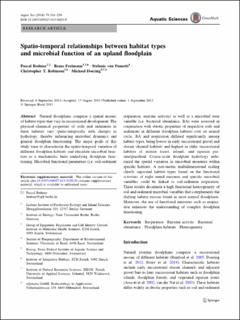Please use this identifier to cite or link to this item:
https://doi.org/10.21256/zhaw-2698| Publication type: | Article in scientific journal |
| Type of review: | Peer review (publication) |
| Title: | Spatio-temporal relationships between habitat types and microbial function of an upland floodplain |
| Authors: | Bodmer, P. Freimann, R. von Fumetti, S. Robinson, C.T. Döring, Michael |
| DOI: | 10.21256/zhaw-2698 10.1007/s00027-015-0420-9 |
| Published in: | Aquatic Sciences |
| Volume(Issue): | 78 |
| Issue: | 2 |
| Page(s): | 241 |
| Pages to: | 254 |
| Issue Date: | Apr-2016 |
| Publisher / Ed. Institution: | Springer |
| ISSN: | 1015-1621 1420-9055 |
| Language: | German |
| Subjects: | Respiration; Enzyme activity; Floodplain; Heterogeneity |
| Subject (DDC): | 500: Natural sciences 577: Ecology |
| Abstract: | Natural floodplains comprise a spatial mosaic of habitat types that vary in successional development. The physical-chemical properties of soils and sediments in these habitats vary spatio-temporally with changes in hydrology, thereby influencing microbial dynamics and general floodplain functioning. The major goals of this study were to characterize the spatio-temporal variation of terrestrial and aquatic floodplain habitats and elucidate microbial function as a mechanistic basis underlying floodplain functioning. Microbial functional variables (i.e., soil-sediment respiration, enzyme activity) as well as a microbial state variable (i.e., bacterial abundance, BA) were assessed in conjunction with abiotic properties of respective soils and sediments in different floodplain habitats over an annual cycle. BA and respiration differed significantly among habitat types, being lowest in early successional gravel and stream channel (i.e., water) habitats and highest in older successional habitats of mature forest, islands, and riparian pasture/grassland. Coarse-scale floodplain hydrology influenced the spatial variation in microbial measures within specific habitats. A non-metric multidimensional scaling (NMDS) clearly separated habitat types based on the functional activities of eight tested enzymes and specific microbial variables could be linked to soil-sediment respiration. These results document a high functional heterogeneity of soil and sediment microbial variables that complements the shifting habitat mosaic found in most natural floodplains. Moreover, the use of functional measures such as respiration enhance the understanding of complex floodplain functioning. |
| Further description: | Erworben im Rahmen der Schweizer Nationallizenzen (http://www.nationallizenzen.ch) |
| URI: | https://digitalcollection.zhaw.ch/handle/11475/8242 |
| Fulltext version: | Published version |
| License (according to publishing contract): | Licence according to publishing contract |
| Restricted until: | 2021-05-01 |
| Departement: | Life Sciences and Facility Management |
| Organisational Unit: | Institute of Natural Resource Sciences (IUNR) |
| Appears in collections: | Publikationen Life Sciences und Facility Management |
Files in This Item:
| File | Description | Size | Format | |
|---|---|---|---|---|
| 2016_Döring_SpatioTemporal Relationships_Aquatic Sciences.pdf | 1.06 MB | Adobe PDF |  View/Open |
Show full item record
Bodmer, P., Freimann, R., von Fumetti, S., Robinson, C. T., & Döring, M. (2016). Spatio-temporal relationships between habitat types and microbial function of an upland floodplain. Aquatic Sciences, 78(2), 241–254. https://doi.org/10.21256/zhaw-2698
Bodmer, P. et al. (2016) ‘Spatio-temporal relationships between habitat types and microbial function of an upland floodplain’, Aquatic Sciences, 78(2), pp. 241–254. Available at: https://doi.org/10.21256/zhaw-2698.
P. Bodmer, R. Freimann, S. von Fumetti, C. T. Robinson, and M. Döring, “Spatio-temporal relationships between habitat types and microbial function of an upland floodplain,” Aquatic Sciences, vol. 78, no. 2, pp. 241–254, Apr. 2016, doi: 10.21256/zhaw-2698.
BODMER, P., R. FREIMANN, S. VON FUMETTI, C.T. ROBINSON und Michael DÖRING, 2016. Spatio-temporal relationships between habitat types and microbial function of an upland floodplain. Aquatic Sciences. April 2016. Bd. 78, Nr. 2, S. 241–254. DOI 10.21256/zhaw-2698
Bodmer, P., R. Freimann, S. von Fumetti, C.T. Robinson, and Michael Döring. 2016. “Spatio-temporal relationships between habitat types and microbial function of an upland floodplain.” Aquatic Sciences 78 (2): 241–54. https://doi.org/10.21256/zhaw-2698.
Bodmer, P., et al. “Spatio-temporal relationships between habitat types and microbial function of an upland floodplain.” Aquatic Sciences, vol. 78, no. 2, Apr. 2016, pp. 241–54, https://doi.org/10.21256/zhaw-2698.
Items in DSpace are protected by copyright, with all rights reserved, unless otherwise indicated.